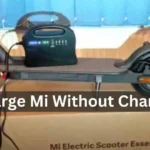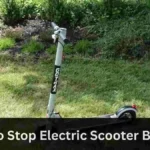Charging your electric scooter without the original charger is not recommended due to potential dangers and the risk of damaging the scooter or battery.
However, in critical situations where no other options are available, there are risky methods that, if approached with extreme caution, can be considered for how to charge gotrax scooter without charger. Additionally, we’ll explore some safer alternatives to ensure a secure and effective charging process.
How To Charge Gotrax Scooter Without Charger:
1. AutoZone Assistance:
AutoZone offers free battery charging services for automotive, power sport, lawn and garden, and marine batteries. Their fast charger can charge most automotive batteries in about 30 minutes.
Additionally, they can also trickle-charge batteries, which is an overnight job, and it’s offered for free as well.
Therefore, if you are in the United States and have a battery, including a scooter battery, that needs charging, AutoZone can provide this service for free.
2. Locate Tesla Charging Station:
Can I charge my electric scooter at a tesla charging station? Charging an electric scooter at a Tesla charging station is not straightforward, and it would require additional equipment and considerations. To charge your electric scooter at a Tesla charging station:
DC-DC Converter or Transformer: You would need a DC-DC converter or transformer to convert the Tesla charging station’s power supply (DC) to the required input for your electric scooter (which typically uses AC).
Tesla-Compatible Receptacle: Your scooter would need a Tesla-compatible receptacle or an adapter to connect to the Tesla charging station. Tesla uses a proprietary connector, so compatibility is a key factor.
Electronics for Compatibility: You might need additional electronics to make the Tesla charger work with your scooter and to ensure that the charging process is safe and doesn’t overcharge your scooter’s battery.
Charging Time: Charging at a Tesla station may not significantly reduce charging time compared to charging at home, as charging rates are often determined by the scooter’s battery design. Expect several hours for a full charge.
3. Solar Charging:
Charging an electric scooter via solar power is technically possible, but it comes with several practical challenges and considerations:
Solar Panels: You would need solar panels to harness sunlight and convert it into electricity. Portable and foldable solar panels are available, but they might not provide sufficient power for faster charging.
Power Station with Inverter: The solar panels would need to be connected to a power station with a built-in power inverter. The inverter converts the direct current (DC) from the solar panels into alternating current (AC), which is what your scooter charger uses.
Wattage and Size: The solar setup would need to have a sufficient wattage to recharge your scooter within a reasonable time frame. A higher wattage would mean faster charging, but it could also result in a larger and heavier setup. Carrying a sizable solar setup on your scooter might be impractical due to weight and size constraints.
Cost Considerations: Building a solar charging setup for your scooter could be expensive. The cost of high-quality, efficient solar panels and a suitable power station may outweigh the benefits, especially for a relatively inexpensive scooter like a Gotrax.
Charging Time: Even with a decent solar setup, charging an electric scooter via solar power would be a slow process. It might take an entire day or more of exposure to sunlight to achieve a significant charge.
4. DIY Charger:
Facing an issue with their 48-volt, 2-amp hour electric scooter charger not fitting the charging port, Opt to replace the connector with a personally crafted solution, the process included clipping the original connector, introducing a new charging port, and proceeding to hardwire and solder the wires.
Emphasizing the importance of disconnecting the power tab before any modifications to prevent potential issues, the individual utilized a multimeter to identify positive and negative wires. The standard red and black colors indicated the correct polarity, providing clarity in cases where wire colors differed.
With the new charger setup ready, the individual plugged it in, and the multimeter confirmed the correct polarity. The modified charger successfully charged the electric scooter to a complete 100 percent capacity.
5. Using a Compatible Power Bank:
You can charge your electric scooter with a power bank. Power bank’s just act as a second battery that is portable and can charge your electric scooter battery.
But for this you should have to take care of a few things; match the scooter battery voltage with the power bank output. check for a compatible charging port on the scooter. use a high-quality power bank designed for Li-ion batteries.
The thing that makes using power bank’s a best choice for charging is that they are portable, light weight, and can be secured in front or back baskets of an electric scooter with wires going to the charging point of the electric scooter battery.
6. Using Another Electric Scooter Charger (Advanced Users Only):
A charger or charging cable is essential for operating an electric scooter, as it regulates the power supply. Using the original charger provided by the manufacturer is ideal for optimal performance. If the original charger is unavailable, consider checking with local electric scooter users of the same brand.
In the absence of a similar brand, it is crucial to pay attention to charger and battery compatibility. Ensure that the voltage and charging profiles match for both the charger and the scooter’s battery. Utilizing chargers from reputable brands with safety certifications is advisable.
It is recommended to proceed with charger-related actions only if you possess the required electrical expertise to avoid potential hazards
7. User Suggestions:
Battery Tender: Purchase a battery tender for effective and safe charging..
Portable Charging Station: Invest in a portable power station (Ecoflow River Pro) with A/C outlets for scooter charging.
Use Outlets in Public Places: Seek outlets in parks, gas stations, or any public area for a quick charge.
Online Resources: Use websites like PlugShare to locate nearby charging options.
Conclusion:
While alternative charging methods exist, they are risky and should only be considered in emergencies. Prioritize safety and explore safer alternatives, such as charging stations, public outlets, or seeking assistance from professionals.
Always use the original charger or a compatible replacement for the best and safest charging experience.



